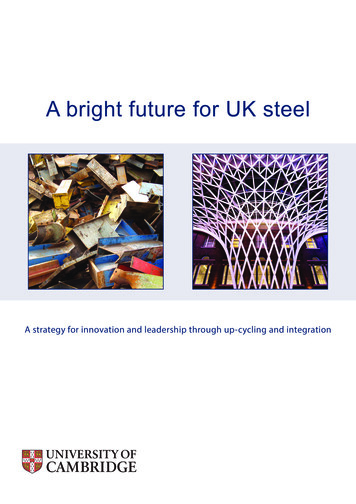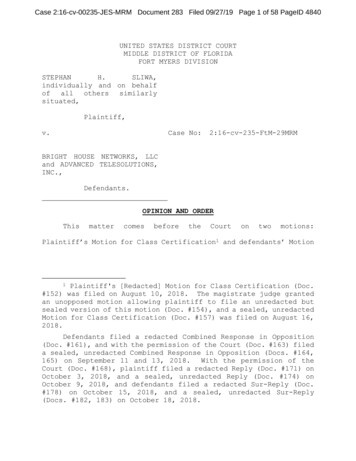
Transcription
A bright future for UK steelA strategy for innovation and leadership through up-cycling and integration
A bright future for UK steelA strategy for innovation and leadership through up-cycling and integrationJulian M AllwoodCopyright 2016 University of CambridgeFirst published April 2016ISBN 978-0-903428-38-5The author has asserted his right under the Copyright, DesignsAnd Patents Act 1988 to be identified as author of this workJulian Allwood is Professor of Engineering and the Environmentat the University of Cambridge. He worked for 10 years for thealuminium industry, and now leads a research group of morethan twenty full time post-doctoral and graduate researchersexploring the opportunity to reduce the greenhouse gas of theenergy intensive industries by making less new material. From2009-2013 he held an EPSRC leadership fellowship to developwork on Material Efficiency, and subsequently won furtherfunding to extend this work, in collaboration with industrialpartners spanning the full supply chain of the bulk metals. He isa member of the UK’s Energy Research Partnership, was a leadauthor of the 5th Assessment report of the IntergovernmentalPanel on Climate Change, and is an Honorary Fellow of theInstitute of Materials, Minerals and Mining.Julian M AllwoodProfessor of Engineering and the EnvironmentDepartment of Engineering, University of CambridgeTrumpington Street, Cambridge CB2 1PZ, United Kingdom.Contact via Mrs Kirsten Helene SawardPhone: 44 (0) 1223 748561Email: khs29@cam.ac.ukThe motivation for releasing this report in April 2016 at a timeof profound crisis in the UK steel industry, is to attempt to bringincreased focus on the need to rethink the way we produceand use steel – and to promote the opportunity for the UK tobecome globally leading in a transformed steel sector, fit for the21st Century.The background to this report was published in the 2012book “Sustainable Materials: with both eyes open” (www.withbotheyesopen.com). The particular focus on up-cyclingand integration as a strategy for the European Steel Industrywas first presented in an article “The future of steel: time towake up” in January 2016, in “Materials World”.
Executive SummaryTata Steel is pulling out of the UK, for good reasons, andthere are few if any willing buyers. It appears therefore thatUK taxpayers must either subsidise a purchase or acceptclosure and job losses. This document presents a third option,to allow a transformation of the UK’s steel industry, basedon two innovations. Firstly, the global supply of steel forrecycling will treble or more in the next thirty years, but theprocesses of recycling have lacked innovation. At presentused steel is generally down-cycled to the lowest value steelapplication, reinforcing bar. Instead, UK strengths in materialsinnovation could be applied to up-cycle used steel to today’shigh-tech compositions. Secondly, the incumbent industrymakes undifferentiated intermediate products such as plates,bars and coils of strip with low margins. Much more value isadded to steel by downstream businesses that convert thesestock products into the tailored components wanted by finalcustomers. New integrated business models could connectliquid steel production to the UK’s world-leading skills inarchitecture and construction, aerospace, automotive andother sectors, to find new value and innovation. This documentuses evidence built up over six years of applied research byfifteen researchers funded by the UK’s EPSRC and industrialpartners spanning the global steel supply chain, to set out thecase for this strategy, and propose an action plan.The global steel industry today has more capacity for makingsteel from iron ore than it will ever need again. On averageproducts made with steel last 35-40 years and, because it ismagnetic, around 90% of all used steel is collected. The supplyof steel collected from goods at the end of their life thereforelags the supply of new steel by about 40 years. It is likely that,despite the current downturn, global demand for steel willcontinue to grow, but all future growth can be met by recyclingthe existing stock of steel. We will never need more capacityfor making steel from iron ore than we have today. The steelindustry in Europe, with older assets and higher labour coststhan in China, is therefore in a critically difficult position,regardless of local variations in energy and labour costs or thetemporary protection of trade subsidies.The focus of European steel makers in the past three decadeshas been to consolidate their operations, and to seekinnovation in material composition and quality. This has ledto impressive technical achievements in the properties ofadvanced steel which is sold at higher prices. However, thisfocus has drawn attention away from two areas which are nowripe for innovation: The quality of recycled steel is generally low, due to poorcontrol of its composition, but there are many technicalopportunities for innovation to address this and converttoday’s down-cycling to future up-cycling. The steel industry today makes largely undifferentiatedintermediate goods, and fails to capture the value andinnovation potential from making final components. Asa result, more than a quarter of all steel is cut off duringfabrication and never enters a product, and most productsuse at least a third more steel than actually required. Themakers of liquid steel could instead connect directly tofinal customers.These two opportunities create the scope for a transformationof the steel industry in the UK. Existing strengths in materialstechnologies could be re-directed towards upgrading recycledsteel. The construction industry that delivered the LondonOlympics, our leading aerospace industries, and resurgentautomotive sector provide the network of partnershipsrequired to re-connect the production of liquid steel to its finalusers.In response to Tata Steel’s decision, UK taxpayers will have tobear costs. If the existing operations are to be sold, taxpayersmust subsidise the purchase without the guarantee of a longterm national gain. If the plants are closed, the loss of jobs,income and livelihoods will reverberate throughout the UKsteel supply chain. The costs of lost tax income and additionalbenefit payments alone are estimated at 300m- 800mper year and will ultimately be born by taxpayers. Instead,the strategy presented here enables taxpayers to invest ina long term structural transformation. This would allow UKinnovation ahead of any other large player, with the potentialof leadership in a global market for used steel that is certain totreble in size.The government of Denmark’s Wind Power Programmeinitiated in 1976 provided a range of subsidies and support toits nascent wind industry. This leadership allowed it to establisha world-leading position in a growing market. This documentproposes that a similar initiative by the UK government couldmirror this success and transform the steel industry. Rapidaction now to initiate a task force to identify the materialstechnologies, business model innovations, financing andmanagement of the proposed transformation could convertthe vision presented here to a plan for action before thedecision for plant closure or subsidised sale is finalised.A bright future for UK steel1
Steel in the world todayBIron ore1002ReductionSteelmakingBlast furnaceOxygenblown furnaceCastingContinuouscasting (slab)Rolling / FormingHotmillEnd-use productsACold rolled coilPig iron 928DirectreductionScrappreparationEnd-of-lifescrap 290Scrap steel 570Liquid steel 892OpenhearthfurnaceElectricfurnace640Plate mill125Continuouscasting (billet)Rod andbar lHRC galv.Hot rolled coil176HR narrow stripElectricalPlate484ConstructionWelded tubeSeamless tube462Buildings596Liquid steel 407Reinforcing barInfrastructureWire rodHot rolled barSection mill94Rail sectionLight sectionHeavy sectionSteel product castingEnd-of-lifecast iron scrapVehiclesCoatedGalvanisedTin platedElectrical540Ingot mill89Continuouscasting (bloom)99DFabricationCColdrolling millMetal goods177Cast steelIron foundry casting68PackagingAppliancesOtherCast ironForming scrap 99Global steel flows for2008 in million tonnesFabrication scrap 186Steel is the world’s most used metal, by far, and we make over200 kg of liquid steel each year for every person alive. Thefigure above illustrates the ‘flow’ of steel through the worldeconomy in 2008, with the width of each line proportional tothe mass of steel produced. Since 2008, the volume of steelproduction has increased, but the proportions of the flowshave remained similar.The figure below shows estimates of the predicted lifespanof the new products made from steel in the same year. Onaverage, steel goods last for 35-40 years, but because steel ismagnetic it is easily separated from other wastes and is ourmost recycled material. Apart from 10% of steel used belowthe surface (for oil pipes or building foundations, for example)almost all end of life steel will be recycled.Four key points are marked on the figure:Steel end use 1025 Mte/yearGlobal tonnage (2008)A.B.C.More than half of all steel is used in construction, withthe other major uses being the manufacture of vehicles,industrial equipment and final goods.Roughly two thirds of today’s liquid steel is made fromiron ore, with the rest made from scrap, but at presentmore than half of this scrap is from the manufacturingprocess itself, rather than from end-of-life goods.The steel industry makes the intermediate productsshown, and sells most of it through stockists to adownstream supply chain.Average life expectancyfor steel 38 years1000 MteDomestic appliancesPackagingElectrical machineryMechanicalmachinery750 MteRailLine pipeBridges, tunnels,offshore500 MteBuildings (officeblocks, industrialsheds etc.)250 MteD.2A quarter of the finished steel made each year (includinga half of all sheet steel) never makes it into a productbut is cut off in manufacturing because final users wantcomponents (such as car doors) that do not closely matchthe intermediate products (coils of strip steel).A bright future for UK steelOthermetalproductsOtherShipsTrucksCars0 Mte012.52537.550Expected life span (years)62.5
Future demand for ,000GDP ( /person/year)190020002100The forecast for future global steel demand shown below isconsistent with these patterns of national 000The figure above shows this tendency towards saturation forseveral developed economies: once we have enough vehicles,infrastructure and buildings we cannot use more, so ourrequirement for steel is then to replace these 12 tonnes every35-40 years. This requires about 300 kg of steel per person inthe UK per year – 50% greater than the global average.We can estimate future global demand for steel by lookingat how developing economies build up their stocks, and howdeveloped economies maintain them. The next figure showsthis pattern over time for the same countries as above, andalso gives an illustrative forecast of the build-up of stocks inChina and India. The steepest gradient of China’s build up isabout now, which is why China’s steel capacity has expandedso much in the past two decades, and why, having passedits peak rate of construction, China now has surplus steel toexport.Total demand (Mtonnes)Stock (tonnes/person)1216Stock (tonnes/person)Steel is traded globally, so it is difficult to predict futuredemand from the history of production in any country.However, estimates of the accumulated stock of steel indifferent countries, show that as countries become richer,their requirement for steel becomes predictable: once wehave a stock of around 12 tonnes of steel per person, we needno more.3000From iron ore1500From scrap01960Year2050Despite the current reduction, the figure anticipates futuregrowth in total demand for steel. However, the figure alsoanticipates the split between steel made from iron ore andsteel made from scrap based on the anticipated lifespan ofsteel products and their recycling rates. This shows that allfuture growth in demand for steel can be met by recycling:the world will never need more capacity for making steel fromiron ore than it has today, but the volume of steel available forrecycling will treble in the next 30-40 years.The current crisis for steel making in the UK is not temporary,and is faced by other European steel makers also. Older assetsfor making steel from iron ore in countries with higher labourcosts have little chance of long term competitive success.Furthermore, if serious action is taken to reduce total globalemissions, then without carbon capture and storage – whichis still unproven except for enhanced oil recovery – the world’stotal production of steel from iron ore must be reduced andmore value captured from the existing stock of steel.A bright future for UK steel3
Steel in the UKRest of worldManufacturingRest of world 16 MtSteel Industry8 Mt13 MtBuildings and infrastructure574 Mt4 MtSteel in end-of-lifegoods3 Mt scrapUKSteel Industry 15 Mt6 MtUKManufacturing13 Mt7 Mt1 MtIndustrialequipment6 Mt9 MtExports of IntermediateSteel ProductsIf the stock of steel stabilises, we can anticipate that over thenext two decades, around 20 million tonnes will be discardedannually. In particular, the rapid growth in demand for steel inA bright future for UK steelScrap torecycling97 MtVehiclesMetal goods1 MtEstimatedlost scrapExports of Steel Embeddedin Final GoodsSteel is not demanded for its own sake. It’s embedded infinished products. Demand for finished goods bought or madein the UK in 2007 necessitated the production of 44 milliontonnes of steel. 10 million tonnes of this was scrapped duringproduct manufacturing processes. 14 million tonnes wereexported in finished goods and 20 million tonnes stayed inthe UK, embedded in the stock of buildings, infrastructure,machinery, cars and equipment. Steel used in buildings andinfrastructure has a longer lifespan than in cars or equipment.So although the UK stock has nearly stabilised, only 10 milliontonnes of steel were discarded. 90% of this was collected forrecycling, of which around two thirds was exported.49 Mt42 Mt104 Mt2 Mt10 MtUK in-use stock816 Mt20 Mtconstruction which occurred in the UK during the 1970’s willturn into a boom in demolition and steel recycling.UK steel industry assets, mainly owned by Tata Steel, werelargely constructed in the 1960’s and are configured toproduce steel from (imported) iron ore. Continuous efforts tooptimise and upgrade these assets have achieved remarkableperformance, but inevitably, they now lag behind the latestplant installed in China in the past decade.However, if the UK steel industry were transformed to processused steel rather than iron ore, scrap which is exported atminimum value today, could be upgraded either for highervalue export as intermediate goods, or converted into finalgoods for domestic use or export.
Steel recyclingUntil the innovations of the Darby family, Bessemer, Siemensand other 19th Century pioneers, the challenge of steelmaking was to remove carbon from the liquid iron to avoidunwanted brittleness. Subsequently, materials scientists haveexplored the addition of increasingly exotic elements fromthe periodic table to increase steel’s strength and tailor itsperformance for applications such as high strength bridges,lightweight bicycles or high temperature engines. The keyinnovation in the first phase of this story was to blow oxygenthrough the liquid iron: carbon in the steel is attracted to theoxygen, leaving behind a purer liquid.then can be used only to make one of the lowest value products– reinforcing bar. Because reinforcing bars are surrounded inservice by concrete, they can tolerate up to 0.4% copper, butthe flat steel needed to make cars can accept only 0.1%. Thisun-separated copper would have been worth around 20 percar if collected, and flat automotive steel has a higher valuethan reinforcing bars.Steel recycling from old cars today is therefore largelydown-cycling because of copper contamination. A furtherconsequence of current practice is that many of the valuablealloying elements used in modern steels are lost in theprocess. Economically and geopolitically important metalssuch as chromium, nickel and molybdenum used in significantproportions in car steels are not managed at end-of-life, soalso end up in reinforcing bars, where their unique propertiesare not used. Managing the valuable elements embedded insteel stocks could therefore contribute to addressing concernsabout the future security of supply of critical metals.Current steel recycling technology creates a liquid metal bymelting a mix of steel scrap in an electric arc furnace, andattempts the same means of purification. However, althoughoxygen is effective in removing carbon, it does not remove allother impurities, and tin and copper are a particular problem.Tin used to coat steel cans for packaging, and copper used inmotors and wiring in cars and appliances, prefer iron to oxygen,so remain in the molten steel, and degrade the performance ofthe recycled material.The supply of used steel for recycling is going to treble andcurrent practice is largely down-cycling. This signals anopportunity for innovation, but recycling also has the criticaladvantage of being much less energy intensive than steelmaking from iron ore. Steel is made from iron ore using coal,and from scrap using electricity. With today’s mix of electricitysupply in the UK, the total greenhouse gas emissions frommaking a steel component from recycled metal are around halfthose when making the steel from ore. If in future, the supplyof low-carbon electricity expands, the emissions associatedwith recycled steel could drop further, and in the limit, couldapproach zero.This is illustrated in the figure which is a subset of that onpage 2 and illustrates the current use of steel in cars. Thehighest quality of steel is used to make the latest car models,which include around 750kg of steel and 25kg of copper inelectric motors and wiring. Old cars are partially dismantledthen crushed and shredded, which mixes the steel with theremaining copper, about 0.7%. The copper cannot be removedfrom the liquid steel by oxygen blowing, so recycled car steelmust be diluted by new metal made from iron ore, and evenReductionIron ore184SteelmakingBlast furnaceOxygenblown furnacePig iron 153Liquid steel 107CastingContinuouscasting (slab)Slab 107Rolling / FormingHotrollingColdrolling102FabricationEnd-use productsGalvanising9054 0.1Cars8636 0.212 0.359 0.4Cast iron 13Continuouscasting (billet)Home/fabricationscrap 38Electric arcfurnaceEnd-of-lifevehicles 58Liquid steel 68Billet 101 0.5Rod and bar millHot rolled bar and tube 1924595 0.6 0.7Reinforcing bar95 0.7Copperconcentration (%)A bright future for UK steel5
Innovation: up-cyclingIn the past fifty years innovation in steel processing has beenincremental, and the trophies of innovation in the world ofsteel have been awarded for new compositions. The strength ofsteel has risen by a factor of nearly ten, while other propertiesrelated to manufacturing, electrical performance, corrosionresistance and many more, have been significantly improved.Not surprisingly, steel recycling has attracted less interest –while recycling is predominantly from internal scrap, there hasbeen less motivation to improve it – and therefore it is a richfield for innovation. Despite the fact that copper and tin arenot attracted to oxygen, there are no fundamental physical orchemical barriers to up-cycling by controlling the compositionof molten used steel and the figure demonstrates many otherareas for new developments:4.There are many options to purify molten scrap steel otherthan oxygen blowing. The diagram below presents asurvey of many approaches that have been tried briefly inresearch laboratories in the past 40 years, but abandonedat the time because of a lack of commercial interest.Technologies being developed to handle metals in wasteelectronics could be transferred to Top Blow NH3/Ammonia GasRolling / Forming Fabrication End-use products6AdsorbInject Pulverized FeCl2 Inject Alkali Silicates Electrochemical MethodForm CompoundVaporizeReductionCeramic FiltrationO2/Cl2 GasForm CompoundVaporizeForm CompoundVaporizeCarsChloride SlaggingIron oreForm CompoundVaporizeForm CompoundSulfide MatteForm CompoundMeltSulfide SlaggingForm CompoundMix with other liquid phaseAnodically DissolvePreferential MeltingMeltMetallic SolventMix with other liquid .612345Reinforcing barSteel-bearing products at end-of-life could bedisassembled with more care, to maintain largercomponents and avoid alloy mixing. In some constructionprojects, I-beams could be re-used directly creating thesame business opportunity exploited by authorised ownbrand used car dealers.Cars and appliances are currently shredded to allow rapidseparation of non-metallic components. However thiscreates mechanical bonds between steel and copperfragments, and other impurities. New approaches toimprove this process, for example with robotic cuttingand handling, could greatly increase the control andhence value of the separate material streams.Novel sorting technologies, such as laser inducedbreakdown spectroscopy, are emerging to allowautomated sifting of mixed waste streams but have todate had little application in steel recycling.A bright future for UK steel5.New processes, such as belt casting can be developedto allow processing of less pure steels into higher valueproducts.6.Product designs can be modified to simplify the challengeof steel recycling, by reducing the use of unwantedelements such as copper, or by enabling more rapidseparation at end of life.At present, with global over capacity throughout the steelsector, scrap prices are at an all time low, so scrap could bestockpiled. This scrap pile – the UK’s annual steel scrap wouldcover Hyde Park to a depth of six metres – will become thefeedstock of future up-cycling, and can be organised by ease ofcomposition control to allow phasing in of new technologiesas they become available.The UK has always been a leader in materials innovation – the2010 Nobel Prize in Physics celebrated the first experimentswith Graphene in Manchester, the most advanced bainitic steelswere developed in Cambridge, and across the UK researchand development of electronic, bio, nano and other novelmaterials is spinning out from research into entrepreneurialbusiness. These strengths could be focused rapidly on the keychallenges of up-cycling steel.
Innovation: integrationSteel usedin the final componentStandardI-beamStamping scrapBlanking scrapConstant width strip of steel fed inthis direction to repeat the partSteel framed fromcommercialbuildingsHalf of allFordsheetfamouslysteel is scrappedHenryowned everythingthe minetomust meetsafetystandardshasofduringmanufacturing:this recentlytheshowroom,but inmorethe e,thecarpaneldoesn’tconsolidated to focus on the production of intermediatecurrentlyby showna factortessellate, andproducts:theextracoils,materialplates,is tubes,bars over-specifiedand sectionsof twoneededfor2.gripwhile standardit is shaped formsonpageTheseare globally traded, largelyHenry Ford famously owned everything from the mine tothe showroom, but more recently the steel industry hasconsolidated to focus on the production of intermediateproducts: the coils, plates, tubes, bars and sections shownon page 2. These standard forms are globally traded, largelyundifferentiated and mainly sold through stockists. As a result,the steel industry operates at a distance from many final usersof steel, and the four case studies above illustrate the resultinginefficiencies.High growth businesses like Apple or Google have intimateconnections to their customers to seek every possibleopportunity for adding value to their offerings. The steelindustry’s disconnection from its customers illustrated in thesecase studies, creates inefficiencies which could be addressedby new integrated business models: Variable cross-sectionbeamOver-specification of beams in an office floor(100% exactly meets the Eurocode requirements) 133% 133 - 200% 200 - 400% 400%50% of all sheet steel is scrapped in manufacturing, thescrap is often returned in mixed form, and may be coatedwith paint, tin or zinc, creating a challenging recyclingproblem. Yet the clothing and textiles industry facesa similar problem and returns just 20% of its materialas scrap. New cutting and forming processes, and newbusiness models with many customers served from eachsteel coil, could be developed and implemented by aconnected steel industry.steel is made so efficiently that it is cheap relative toUK labour, so excess steel is often used to make smallreductions in labour costs. A connected innovating steelindustry could add more value to less steel by producingFloors deflect most furthest fromBuildings are designed for 100the walls, so floor beams shouldyears but on average replacedhavecross-section.much sooner, and the steel couldStandard I-beams use 30% morebe re-used, as in this temporarysteel than necessary, to no benefitstructure.avariableexactly the components required by designers, integratingthe liquid metal processes with downstream forming andfabrication, finding new efficiencies in joints and modulardesigns, and supplying kits of final parts ready for userather than stock intermediate goods. the disconnect between steel makers and users createdby steel stockists creates artificial economies of scaleaiming at reducing costs to the stockists, not to the finalcustomer. The current disconnected steel industry is inmany cases unable to tailor its production to end userneeds, because steel makers don’t know what’s actuallyrequired. large components, particularly in construction, are oftenundamaged in service, and could be re-used rather thanmelted. However the supply-chain for re-use doesn’t exist,so re-use imposes very high search costs on interestedclients. In contrast, the automobile sector has soughtto internalise the value of second hand sales, throughauthorised re-sellers, providing certification and serviceguarantees, and holding sufficient stock to match supplywith demand. A connected customer-oriented steelindustry could do the same.The UK is globally leading in architecture, construction,aerospace, automotive and other sectors downstream of thesteel industry, and has the networks and skills required toseek new forms of business models by finding new and richconnections between steel suppliers and their final users.A bright future for UK steel7
Steelmaking costsThe major components of cost in making steel are the purchaseof iron ore, scrap and other physical inputs, the purchase ofcoking coal or electricity, labour and capital costs. The truecosts vary by the age, location, design and utilisation of eachsite and are commercially sensitive, so invisible. However,using a cost model provided by a UK consultant, with datafrom publically available sources, the figures below give anestimate of the costs of producing one tonne of liquid steel,from iron ore or scrap in the UK over the past five years. Inboth cases, the cost of producing the intermediate goods thatwill be sold will be greater than this – due to the casting, rollingor other processes that occur after the liquid steel is prepared,but these costs will be similar for either route. /tonne steel: steel made from iron oreIf the steel made from scrap is down-cycled to lower valueapplications such as reinforcing bar, these estimates showthat the iron ore route remains attractive – the costs of bothroutes are similar. However, if used steel is up-cycled, it can becompetitive against steel made from iron ore. Further, as theglobal supply of scrap for recycling is certain to expand, thecost of scrap relative to iron ore is likely to fall.Both process routes are influenced by the price of electricity– even though coal is the dominant energy cost for steel fromore. This is a major challenge in the UK. The figure below,using data from the UK’s Department for Energy and ClimateChange, compares electricity prices for the largest industrialusers in the UK with selected other larger European countries.400ElectricityCoalScrap steel300200Iron ore10002010Pence per kWh10Other inputsLabourCapital20112012201320142015 /tonne steel: steel made from den24000300Electricity200Scrap steel10002010Other inputsCapital2011201220132014Labour2015The figures show that8 the largest component of cost in both cases is theacquisition of the raw material – iron ore, coke or scrap.Both have declined significantly during this period, andso has the cost of steel making, driven by global overcapacity. energy drives around one third of the cost of making steelfrom iron ore, and one sixth of the cost from scrap, butboth routes are sensitive to variations in electricity prices. labour is a relatively small component of cost. Capital costsare more important, and these are the most uncertainelements of these estimatesA bright future for UK steel20112012201320142015UK electricity is significantly more expensive than all othercountries shown, and is the most expensive in the EU28.Relative to the median price across the EU28, UK electricityprices are nearly 80% higher.Electricity prices are strongly influenced by governmentpolicy – on capacity planning, generation mix, taxes and otherregulation. There are many options to modify these prices,and one example relevant to the proposal in this document,is that the electric arc furnaces used in making steel fromscrap are intermittent batch processes. As the UK movestowards a stronger mix of renewable supplies, the challenge ofbalancing the t
Global tonnage (2008) Steel end use 1025 Mte/year Other Packaging Average life expectancy for steel 38 years 0 12.5 25 37.5 50 Expected life span (years) 62.5 Buildings (o ce blocks, industrial sheds etc.) Bridges, tunnels, o shore Steel is the world's most used metal, by far, and we make over 200 kg of liquid steel each year for every .











